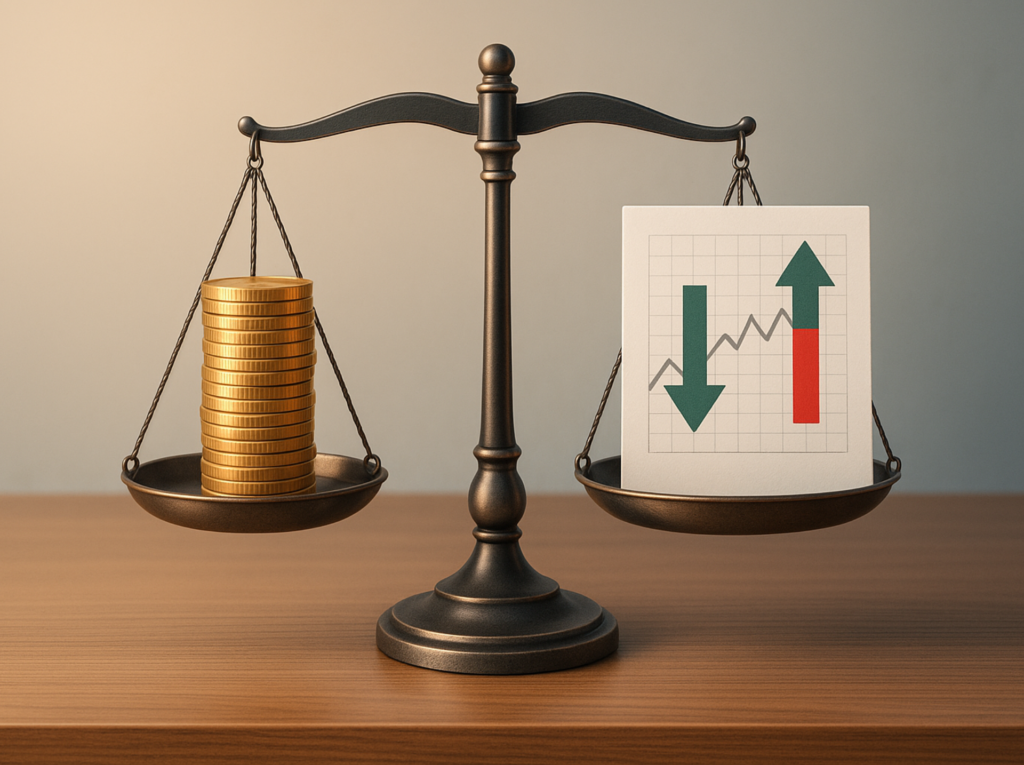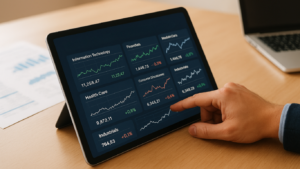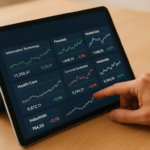When trading, two metrics stand out: win-loss ratio and profit-loss ratio. These help you understand your trading performance. Here’s the difference:
- Win-Loss Ratio: Measures how often you win compared to losing. Formula: Winning Trades ÷ Losing Trades. A ratio above 1 means more wins than losses.
- Profit-Loss Ratio: Focuses on the value of wins vs. losses. Formula: Average Profit per Win ÷ Average Loss per Loss. A ratio of 2:1 or higher is ideal.
Key Insight: A high win-loss ratio doesn’t guarantee profits if your losses are much larger. Similarly, a strong profit-loss ratio won’t help if you rarely win. Combining both metrics provides a clearer picture of your strategy’s success.
Example:
- High Win-Loss, Low Profit-Loss: Winning 8 out of 10 trades (win-loss ratio = 4), but small wins (S$50) and large losses (S$300) result in a net loss.
- Low Win-Loss, High Profit-Loss: Winning 4 out of 10 trades (win-loss ratio = 0.67), but big wins (S$600) and small losses (S$100) lead to profits.
To succeed, track both metrics together, refine your strategy, and ensure your wins outweigh your losses. Singapore traders can benefit by maintaining a trading journal, managing risks, and focusing on strategies that balance these metrics effectively.
What is Win-Loss Ratio
Definition and Calculation
The win-loss ratio is a simple way to compare the number of winning trades to losing ones over a specific timeframe. Here’s the formula:
Win-Loss Ratio = Number of Winning Trades ÷ Number of Losing Trades
For instance, imagine you make 100 trades over three months, all in Singapore dollars. Out of these, 60 trades are profitable, earning anywhere from S$50 to S$300 each. The remaining 40 trades result in losses, ranging from S$20 to S$200 each. Using the formula, your win-loss ratio would be 60 ÷ 40 = 1.5. This means for every losing trade, you have 1.5 winning trades. It’s worth noting that this metric focuses solely on the frequency of wins and losses, without considering the size of the trades.
Now, let’s dive into what this ratio tells you about your trading performance.
What Win-Loss Ratio Measures
The win-loss ratio shows how often your trading strategy results in profitable trades. A ratio above 1 means you win more often than you lose, while a ratio below 1 indicates the opposite. If the ratio is exactly 1.0, you’re breaking even, with an equal number of wins and losses. For retail traders in Singapore, win rates typically fall between 50% and 70%, which corresponds to ratios of about 1.0 to 2.3. By looking at this ratio, you can assess how consistent and effective your trading approach is.
Win-Loss Ratio Limitations
While the win-loss ratio gives you an idea of how frequently you win, it doesn’t account for the value of those wins and losses, which can significantly impact your overall profitability. For example, you could have a win-loss ratio of 2:1, meaning you win twice as often as you lose. However, if your losing trades are much larger in dollar value than your winning trades, your strategy might still lead to losses.
Let’s break it down: imagine you have 20 winning trades averaging S$100 each, totalling S$2,000. At the same time, you have 10 losing trades averaging S$300 each, adding up to S$3,000 in losses. Despite your 2:1 ratio, you’d end up with a net loss of S$1,000. This example highlights that a high win-loss ratio alone doesn’t guarantee profitability.
To get a clearer picture of your trading effectiveness, it’s crucial to pair the win-loss ratio with other metrics, like the profit-loss ratio and the risk-reward ratio. These additional measures help you evaluate not just how often you win, but how much you gain or lose in the process.
What is Profit-Loss Ratio
Definition and Calculation
The profit-loss ratio is all about understanding the financial outcomes of trades, not just the number of wins and losses. As Investopedia puts it, “The profit/loss ratio is the average profit on winning trades divided by the average loss on losing trades over a specified time period”.
Here’s the formula:
Profit‑Loss Ratio = Average Profit per Winning Trade ÷ Average Loss per Losing Trade
Let’s break it down with an example. Imagine you’ve made 50 trades over two months. Out of those, 30 were winning trades, with an average profit of S$200 each, and 20 were losing trades, averaging S$100 in losses. Using the formula:
- Average Method: S$200 ÷ S$100 = 2.0
- Total Amounts: Total profit (30 × S$200 = S$6,000) ÷ Total loss (20 × S$100 = S$2,000) = 3.0
Notice how the method you use can give different results, especially when the number of winning and losing trades varies. This calculation helps traders evaluate the quality of their trades and sets the groundwork for more detailed analysis.
What Profit-Loss Ratio Measures
While the win-loss ratio tells you how often you win, the profit-loss ratio focuses on the value of those wins compared to losses. A higher ratio means your profits outweigh your losses, which is crucial for staying successful in the financial markets. Many experts recommend aiming for a profit-loss ratio of at least 2:1. A consistent ratio like this can spotlight effective strategies and signal when it’s time to tweak your risk management if the ratio dips.
Challenges in Maintaining a Good Profit‑Loss Ratio
Keeping a strong profit-loss ratio isn’t easy. Traders often fall into the trap of taking quick profits while letting losses pile up, which can throw the ratio off. Market conditions also play a big role – trending markets may let you aim for larger ratios, while ranging markets might require tighter controls. On top of that, your trade execution matters a lot. Even a solid strategy can falter if you mismanage entry and exit points or make risky decisions, like increasing your position size after wins or chasing losses.
Consider this: 85% of day traders fail due to overtrading, but those who use clear stop-loss levels cut their losses by 50%. To improve your ratio, focus on disciplined practices like setting stop-losses, managing position sizes systematically, and keeping a detailed trading journal. A disciplined approach helps you prioritise quality over quantity, limiting your risk to just 1–2% of your account per trade.
Even if you win only 40% of the time, a 1:3 profit-loss ratio can keep you profitable. This highlights why the size of your wins and losses often matters more than how often you win. Understanding these challenges makes it easier to use the profit-loss ratio alongside other key trading metrics effectively.
Key Differences and When to Use Each
Side-by-Side Comparison
Understanding the differences between the win-loss ratio and the profit-loss ratio helps determine when to rely on each. Here’s a quick look at how they stack up:
| Aspect | Win-Loss Ratio | Profit-Loss Ratio |
|---|---|---|
| Definition | Number of winning trades ÷ Number of losing trades | Average profit per winning trade ÷ Average loss per losing trade |
| Focus | Frequency of success | Magnitude of gains versus losses |
| Measures | How often you win | How much you gain on wins versus what you lose |
| Strengths | Shows the consistency of a strategy | Highlights the financial impact of trades |
| Limitations | Ignores trade size and monetary value | Doesn’t consider the probability of wins and losses |
| Best For | Evaluating strategy reliability | Analysing financial performance of a strategy |
In essence, the win-loss ratio tells you how often you’re winning, while the profit-loss ratio focuses on the financial outcome of those wins and losses. Let’s break this down further with some examples.
Practical Examples
High Win-Loss, Low Profit-Loss Scenario
Imagine a trader wins 8 out of 10 trades, giving them a win-loss ratio of 4.0. Sounds great, right? But if each win earns S$50, while each loss costs S$300, the profit-loss ratio is just 0.17 (S$50 ÷ S$300). Despite an impressive 80% win rate, the large losses outweigh the small wins, leading to overall losses.
Low Win-Loss, High Profit-Loss Scenario
Now think of a trend-following strategy that wins 4 out of 10 trades, resulting in a win-loss ratio of 0.67. If each winning trade earns S$600 and each loss costs only S$100, the profit-loss ratio jumps to 6.0. Even with a 40% win rate, the large gains from winning trades more than make up for the losses.
Many experienced traders operate with win rates around 60% or lower, focusing on ensuring their gains outsize their losses. In fact, some succeed with win rates as low as 40–45%, proving that the size of gains often outweighs the frequency of wins.
When to Prioritise Each Metric
Win-Loss Ratio
If you’re testing a new strategy or struggling with the emotional toll of frequent losses, focusing on the win-loss ratio can help. A higher win-loss ratio often feels more reassuring, especially for traders aiming for consistent results.
Profit-Loss Ratio
When it comes to assessing the long-term potential of a trading approach, the profit-loss ratio is key. It offers insight into whether a system can weather market fluctuations and still deliver profits, even during streaks of losses.
Using both metrics together provides a well-rounded view of your trading performance. By understanding where your strategy excels and where it falters, you can make adjustments to improve and aim for sustainable profits.
Master Systematic Trading with Collin Seow
Learn proven trading strategies, improve your market timing, and achieve financial success with our expert-led courses and resources.
Using Both Metrics in Systematic Trading
Combined Approach to Trading Metrics
In systematic trading, combining both the win-loss ratio and the profit-loss ratio gives you a more complete picture of your strategy’s effectiveness. Each metric on its own is only part of the story. The win-loss ratio shows how consistent your strategy is, while the profit-loss ratio highlights its profitability. For instance, a trader with a 3:1 profit-loss ratio can still make money even if their win rate is just 25–30%.
“Profitable and consistent trading is about finding a balance between your win rate and risk/reward ratio.” – Cory Mitchell, CMT
The profit factor ties these metrics together. A profit factor above 2 signals a strong likelihood of profitability, whereas anything below 1.2 suggests that trading costs might outweigh your gains.
Look at how successful strategies balance these metrics. Take the Medallion Fund, for example. With a win rate of only 51%, it still achieved consistent profitability through diversification. This shows that the frequency of wins is less important than maintaining a mathematical edge. This principle is at the core of systematic trading success.
Keep track of both your win-loss and profit-loss ratios in a trading journal. This allows you to spot trends and adjust your strategy as market conditions shift. Don’t just aim for frequent wins – focus on maximising the size of your gains compared to your losses.
Your targets for these metrics should align with your trading style. Scalpers, for example, might prioritise higher win rates with smaller profit-loss ratios. On the other hand, swing traders may accept lower win rates if it means achieving larger profit-loss ratios.
Regularly review these combined metrics to refine your trading edge. This integrated approach not only sharpens your strategy but also prepares you for more disciplined execution. Stay tuned for the next section, where we’ll dive into best practices tailored for Singapore traders.
Best Practices for Singapore Traders
Building on the combined metrics approach, these tips are designed to help traders in Singapore refine their strategies. With a vibrant trading community, Singapore offers a great environment for systematic approaches that minimise emotional decision-making. For example, traders at Collin Seow Trading Academy incorporate both metrics into their daily routines.
- Start with proper position sizing: Determine your risk parameters beforehand and stick to them. Use stop-loss and take-profit levels to avoid impulsive decisions and maintain solid profit-loss ratios.
- Aim for a 1:2 risk-reward ratio or better: Focus on strategies that allow you to win more than half the time. Even if your win rate dips, a strong profit-loss ratio can keep you in the green.
- Track your metrics consistently: Use a trading journal to monitor both win-loss and profit-loss ratios, along with other performance indicators. Regularly review your trade history to spot patterns. For instance, you might notice a high win-loss ratio but a weak profit-loss ratio, or vice versa.
- Keep trading costs low: Spreads and commissions directly affect your profit factor. In Singapore’s competitive brokerage landscape, even small cost differences can significantly impact your long-term results.
- Stick to systematic entry points: Define clear criteria for entering trades to ensure your target ratios are achievable. Avoid relying on gut feelings or hope.
- Avoid overtrading: It’s easy to fall into the trap of taking too many trades when you see temporary success in one metric. Stick to your predefined strategies to maintain balance.
“The win ratio in trading is important and is an underappreciated factor in trading strategy development. A low win rate increases the chances of behavioural mistakes, high drawdowns, and ruin.” – Oddmund Groette
Diversify your trades to spread risk while maintaining your target metrics. This helps smooth out the ups and downs that come with any trading strategy.
Finally, aim for a profit factor of at least 2 to improve your overall trading outcomes. By aligning your win-loss and profit-loss ratios, you can build a sustainable edge over time, ensuring consistent success in your trading journey.
Conclusion
Key Points Summary
To trade successfully, understanding the difference between the win-loss ratio and the profit-loss ratio is essential. The win-loss ratio tells you how often your trades are winners compared to losers, while the profit-loss ratio measures the average profit from winning trades against the average loss from losing trades.
However, neither metric works well on its own. A high win-loss ratio might look good on paper, but a few large losses can easily wipe out numerous small wins. Similarly, a strong profit-loss ratio won’t guarantee success if your win rate is too low. The real key is finding the right balance between these two metrics.
Experienced traders know this balance. Many achieve profitability even with win rates as low as 60% (or less) because their winning trades generate significantly higher returns than their losses. Monitoring and balancing these metrics is critical to identifying weaknesses in your strategy before they lead to major setbacks. For traders in Singapore’s fast-paced markets, this disciplined approach is a cornerstone of long-term success.
Next Steps for Traders
To put these concepts into action, start by integrating both metrics into your daily trading routine. Define clear entry and exit rules that align with your target ratios, and test your strategies thoroughly, accounting for transaction costs and risk management.
Leverage educational tools to refine your approach. The Collin Seow Trading Academy offers a range of resources, including in-depth trading courses, free e-courses, and live webinars, all designed to teach systematic trading methods.
Keep a trading journal to monitor and evaluate your win-loss and profit-loss ratios regularly. This habit will help you improve your strategies over time. For practical guidance, explore resources like The Systematic Trader v.2 and free video tutorials available through the Collin Seow Trading Academy.
Trading WIN LOSS Ratio is USELESS (YOU WILL LOSE) unless you use it with this performance measure!
FAQs
How can traders balance win-loss and profit-loss ratios to achieve consistent profitability?
To manage the balance between win-loss and profit-loss ratios effectively, traders should pay close attention to their risk-reward ratio. Aiming for a ratio of at least 1:3 is a solid strategy. This means that even if your win rate isn’t high, the potential profits from successful trades can still surpass the losses.
Another important factor is adjusting your stop-loss and take-profit levels. Setting realistic targets allows you to maximise gains from winning trades while keeping losses under control. By regularly reviewing these levels and ensuring they align with your risk tolerance and current market conditions, you can build a more sustainable trading approach.
What are the common pitfalls of focusing only on the win-loss ratio or profit-loss ratio in trading?
Focusing only on the win-loss ratio can sometimes lead traders down a tricky path. It might push them to aim for more winning trades while ignoring the bigger picture – how much they’re actually gaining or losing overall. A high win rate might seem impressive, but it doesn’t guarantee success if the losses from losing trades are larger than the profits from winning ones.
On the flip side, zeroing in solely on the profit-loss ratio can also backfire. It might tempt traders into risky behaviours, like increasing their position sizes after a win or trying to recover losses with even bigger trades. These habits can put your account balance at risk and threaten your long-term goals.
To build a sustainable trading strategy, it’s crucial to strike a balance between both metrics. Combine this with solid risk management, a clear trading plan, and the discipline to keep emotions in check, and you’ll be in a stronger position to succeed.
How can traders in Singapore use a trading journal to improve their win-loss and profit-loss ratios?
Traders in Singapore can improve their trading performance by keeping a comprehensive trading journal. This journal should include essential details for each trade, such as entry and exit points, the reasoning behind the trade, the results, and even the emotions experienced during the process. By doing so, traders can uncover patterns in their behaviour and strategies, identify strengths, and pinpoint areas needing improvement.
By reviewing this journal regularly, traders can fine-tune their strategies, sharpen their risk management skills, and stay aligned with Singapore’s ever-changing market conditions. Over time, this habit not only builds discipline and accountability but also helps achieve more consistent profits in the fast-paced financial markets.












